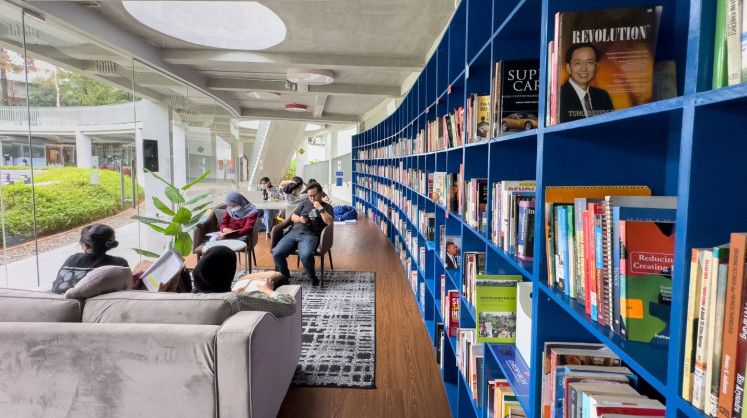We must work with nature to beat floods
Floods are a recurrence in most parts of the world and in Indonesia and other parts of Asia, millions of dollars are spent every year on flood-related mitigation programs
Change text size
Gift Premium Articles
to Anyone

F
loods are a recurrence in most parts of the world and in Indonesia and other parts of Asia, millions of dollars are spent every year on flood-related mitigation programs.
Caught in short-term solutions and focused on 'cemented, engineered' solutions, our urban landscapes have become perfect settings for floods.
While urban (and rural) landscapes are the scene of floods and other natural disasters, our experts and policymakers continue to overlook nature's simple designs.
How does nature restore, rebalance, reenergize and revive the internal adaptive capacity to sustain life on our planet for millions of years? After all, we humans are the new kids on the block.
In our eagerness to outsmart nature, we continue to be caught up in models of climate change and tinker with technology as if we can change the course of nature through these mechanisms.
We continue our obsession with urbanization. Over-cemented urban landscapes, roads and buildings as those in Jakarta simply deprive soils of their absorptive capacity.
With not enough natural run-offs for rainwater to reach groundwater, heavy rainfall creates unnatural disruption to deal with excess water flows from over-cemented narrow canals and drains.
These designs not only prevent excess water from being absorbed by underground water capillaries, they also create further run offs to enter the body of the river as most banks are also cemented over.
The holding capacity of the bodies of water is greatly reduced at a time when they need greater capacity.
Other factors that contribute to flooding include paved roads, sidewalks, residential areas with paved yards and paved parking lots for cars. Municipal sewage systems also contribute a great deal to flooding, often leading to serious health and hygiene issues in flooded areas.
In many areas, cost-cutting measures lead to combined sewage and storm-water drains, or at best these drains run adjacent to the other. Often the pressure is too much and the pipes break, thus mixing sewage with floodwater, leading to most flood-related epidemics.
The touted solution is generally more money for mitigation, increased infrastructure, bigger canals and bigger urban sewage systems. It seems we have forgotten some basic truths about how nature operates. If only we cared to observe nature. If only we had time to spend with nature.
Let us take a minute and examine the flow of a natural river system.
Rivers never flow in a straight line. Constrained, straightjacketed, piped waterways are merely for the convenience of the engineers.
A river in its natural state meanders in a perpetual S shape, flowing in, creating an inward spiral and then folding unto itself, coming out in the opposite direction.
In the process, the force of the water flow folding unto itself creates a spiral vortex.
The vortex system of the river keeps the river alive and allows the water to cool itself. It is simple common sense that cool water contracts and hot water expands.
The shape of the river flow, vortex as well as the riverbank ecosystems with varied canopies of trees, bushes and root system allow the water to cool.
The absorptive capacity of the earth around the riverbanks with myriad root systems allows the water intake to be held through the trunks of the trees and the banks.
The banks of any natural river landscape are always wooded, with roots stabilizing and absorbing excess flows from the rain or flash floods, sending the water to the deepest underground reservoirs.
A combination of micro ecosystems along the banks of the rivers as well as the meandering shape of the rivers, 'break' the flood waters through implosion and vortex formations all along the rivers.
We have forgotten the severity of our interference with hydrological cycles. In the natural state, rainwater seeps through to underground waters, recharging the aquifers, as well as mineralizing, maturing water to resurface again for our use. In the disrupted cycle, we not only get increased rain, but also severe floods.
There are hydrologists and engineers working with the lessons learned from nature, developing simple, cost-effective preventive river and flood management solutions by simply reinstating nature's design principles.
Most of the work in this field is inspired by the Austrian forester Viktor Schauberger, who predicted as early as the 1950s that our reluctance to work with nature would wreak havoc on our planet.
Perhaps learning from nature means we cannot peddle any longer in homogenized technologies. Nature is uniquely diverse, adaptive, resilient to the core and immensely vast. Perhaps we need to ask who benefits from 'disasters'.
Who wants to keep mitigation programs going through globalized homogenized replicable solutions that don't work anyway? Not nature and definitely not the millions of ordinary folks caught in the throes of annual flooding.
The writer is founder and director of the School of Practical Sustainability, currently based in Bali.









